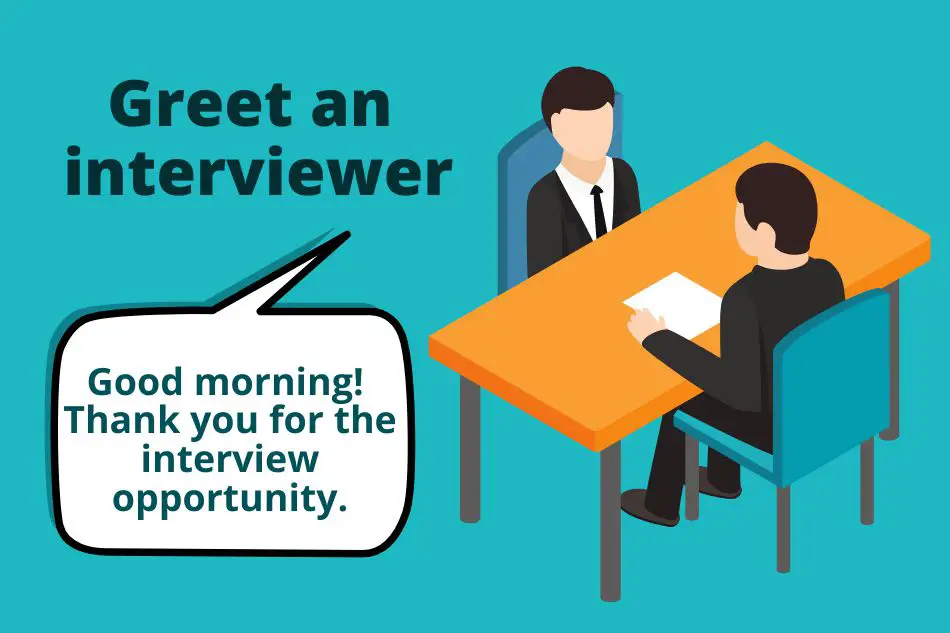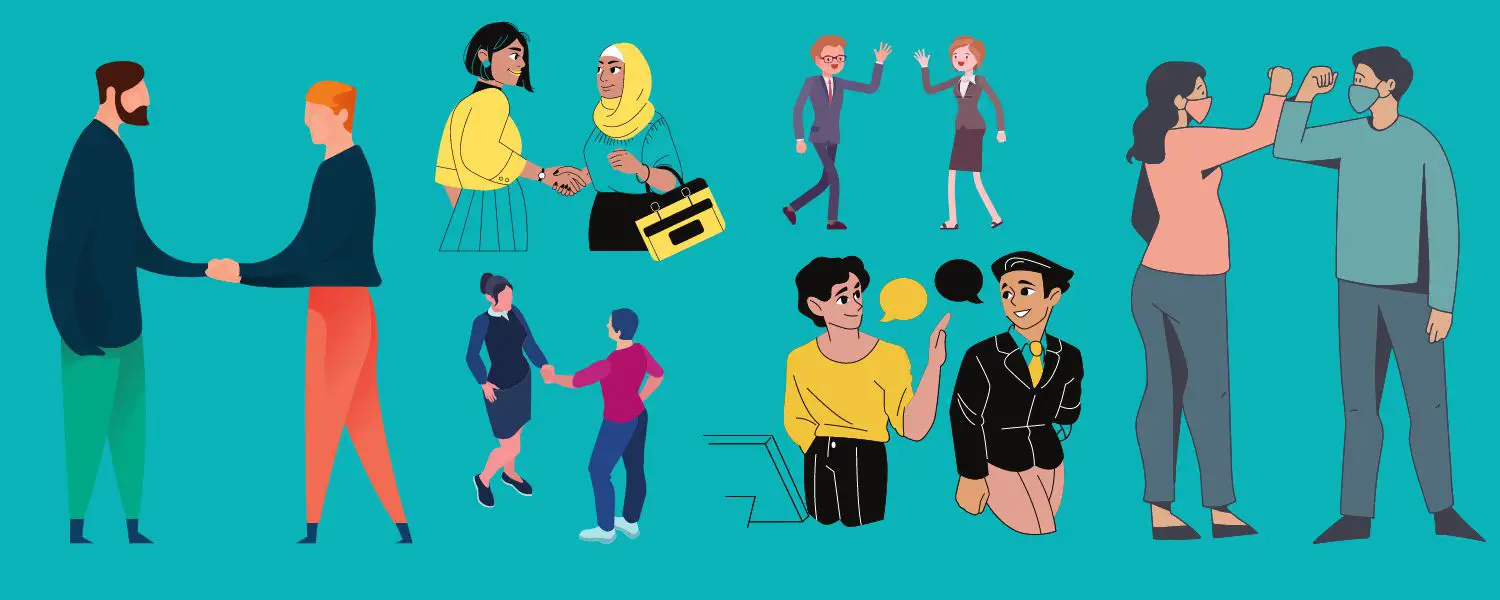This article covers the following areas –
- #1 Greeting a Friend
- #2 Greeting a Stranger
- #3 Greeting an Elderly Person
- #4 Greeting a Customer
- #5 Greeting Your Colleagues
- #6 Greeting a Job Interviewer
- #7 Seasonal Greetings
- #8 Greetings in Letters and E-mails
- 10 Tips to Appropriately Greet Someone in English
- Sample Conversation: Greetings in English
- Concluding Thoughts
- FAQ: Greetings in English
Greetings are the conversation starters, no matter whether you are talking to someone face to face or over the phone. As a greeting creates the first impression, it plays a vital role in determining whether the conversation will go well or not.
The most common formal greeting is “hello,” and “hi” is the most popular way of greeting informally. The way one should greet someone exclusively depends on the setting and the kind of relationship they maintain. You greet your close friends casually, whereas you are expected to maintain formality while greeting someone professionally.

Do you have in your mind right now any other common ways of greeting in English? If yes, you can share them with all of us in the comment box. Also, you can suggest any book that can help my students improve their English, as I suggest you try English Made Easy Volume One: A New ESL Approach: Learning English Through Pictures (Amazon Link). This book creatively uses pictures and text in tandem to revolutionize English language learning, making it easier to understand and more effective overall.
Now, let’s have a quick look at some ways of greeting different people surrounding us such as friends, customers, colleagues etc. Here’s a table presenting various ways to greet different groups of people, including friends, strangers, elderly persons, customers, and colleagues. Each category has three expressions suitable for the respective group:
| Group | Greeting 1 | Greeting 2 | Greeting 3 |
|---|---|---|---|
| Friends | Hey [Name], what’s up? | Hi [Name], how’s it going? | Hello [Name], long time no see! |
| Strangers | Hello, nice to meet you. | Good [time of day], how can I help you? | Hi there, how are you today? |
| Elderly Persons | Good [time of day], Mr./Mrs. [Last Name]. | Hello [Name], how are you feeling today? | Greetings, Mr./Mrs. [Last Name], it’s a pleasure to see you. |
| Customers | Welcome to [Company/Store Name], how can I assist you? | Thank you for choosing [Company/Store Name], how may I help you today? | Good [time of day], thank you for coming in. What can I do for you? |
| Colleagues | Hi [Name], ready for the big meeting? | Good [time of day], [Name], how’s the project going? | Hello [Name], hope the day’s treating you well. |
Each greeting is tailored to fit the context of the relationship and the level of formality typically associated with each group. In the following sections, I’ll share some more examples of greeting friends, strangers, elderly persons, customers, and colleagues.
#1 Greeting a Friend

When greeting a friend, the language is typically relaxed and informal, reflecting the closeness and familiarity of the relationship. The greetings can vary widely, from playful and casual to warm and caring, depending on the context and the nature of the friendship. The key is to convey friendliness and genuine interest in the other person’s well-being. Here are some ways to greet a friend.
- Hi Bryan! How are you?
- Hi James! I’m fine. And you?
- Hey James! How’ve you been?
- Not bad. How about you?
- Howdy! You alright, friend?
- Howdy howdy!
- Yo! What’s going on, man?
- Not much. How about you?
- What’s up! Buddy?
- Nothing much.
- Sup?
- Alright.
- How’s life, mate?
- Great. How’s yours?
- Hiya! Is everything fine?
- Yeah! How about you?
- How’s it going? Long time, no see dear!
- Good. Yeah, it’s been ages.
- Wazzup! Dude?
- Nothing. What’s up, man?
Note: Greeting a friend is always informal. However, you must be polite in your choice of words, tone, and body language while greeting them.
#2 Greeting a Stranger

Greeting a stranger requires a respectful and courteous approach. It often involves a neutral tone and a polite form of address. These greetings are designed to initiate contact in a friendly manner without overstepping any personal boundaries, often prefaced with a gentle request or a kind question to acknowledge the other person’s presence and comfort. Here are some examples of greeting someone you have just met for the first time.
- Hi! Can I sit here?
- Hi! Sure, please.
- Hey! May I talk to you, please?
- Yes, why not?
- Hello! Are you looking for any address?
- Oh yeah! Can you please help me out?
- Good evening!
- Good evening!
- How are you?
- I am fine. And you?
- How are you doing?
- Fine. How about you?
- Good morning to you.
- Good morning to you.
- How do you do?
- How do you do? (The reply is the same. Don’t be surprised)
Note: To start a conversation with a stranger, you may ask for permission from them or make polite requests to talk to you. The above examples show how to do it as a part of greetings. If you know some other ways of doing it, please share them with us in the comment box.
#3 Greeting an Elderly Person

When addressing an elderly person, it’s important to show respect and consideration. Greetings should be courteous and often slightly more formal, acknowledging their seniority. It is appropriate to use titles like Mr., Mrs., or Ms., along with a kind inquiry about their well-being. The tone should convey both respect and warmth. Find some examples below.
- Good afternoon Ms. Watson! How are you today?
- I am fine. How about you?
- Hello sir! How are you?
- I am good, thanks. And you?
- Hello ma’am! Would you care for a drink?
- Oh yes! Thanks.
- Hi grandma! ((You can use what names you have for them, such as grammy or granny)
- Hi sweetheart!
- Hello! May I talk to you?
- Sure! Why not?
- Hey! How are you, grandpa? I missed you a lot.
- I am good! I missed you too, dear.
Note: Don’t mention someone’s age (i.e., senior citizen, old man, etc.) since it may sound impolite to some people. To many people, age is just a number. However, to learn to ask about someone’s age without offending them, you can read another post titled How to Ask Someone About Their Age.
#4 Greeting a Customer

The first interaction with a customer sets the stage for the customer service experience. Greetings should be professional, friendly, and helpful, aiming to make the customer feel valued and welcomed. It’s also essential to offer assistance and be ready to attend to the customer’s needs, demonstrating the service-oriented nature of the business. Here are some appropriate ways of greeting your customers.
- Hello there! How are you today?
- Fine. How are you?
- Hi! How may I help you?
- Not really. But thanks for asking.
- Good morning! Is there anything I can help you find?
- Oh yeah! I am looking for some cashew nuts.
- Should I help you make a decision?
- Please!
- May I know what you are looking for?
- I am looking for the vegetable corner.
- Welcome to Agora. Are you looking for anything in particular, sir?
- Thanks. Where can I find the meat?
- Hello! What may I help you with, ma’am?
- May I talk to your manager? I have something to exchange.
- Good evening! Thanks for visiting our pavilion. We have the best clothes at this fair.
- Good evening! You are welcome.
- Hello! My name is Alex. Can I help you find something?
- I can’t see the price tag. Can you tell me the price, Alex?
- Welcome back, ma’am. Good to see you again.
- It’s my pleasure.
- Hello! It’s been a pleasure meeting you.
- Oh yes! Same here.
#5 Greeting Your Colleagues

Greeting colleagues involves a balance between professionalism and friendliness. The tone can vary from casual to formal, depending on the workplace culture and the relationship with the colleague. For peers, a more relaxed greeting is appropriate, while interactions with senior colleagues or bosses might require a degree of formality, reflecting respect and professionalism. Let’s learn some nice ways of greeting both close colleagues and seniors at the workplace.
For Close Colleagues
- Good morning, Jack!
- Good morning Sara!
- Hello! How are you?
- Great, thanks. And you?
- Hi David! How have you been?
- Good. How have you been, Julie?
- Hey there! Good to see you back.
- Oh, thank you. How have you been?
For Senior Colleagues or Boss
- How do you do?
- How do you do?
- Hello! Good to see you, sir.
- Same here, Joseph. How are you doing?
- Good morning!
- Good morning. How is it going, Elizabeth?
- Good evening! I am pleased to meet you.
- Good evening! It’s my pleasure.
#6 Greeting a Job Interviewer

Greeting a job interviewer is all about making a positive and respectful first impression. It is crucial to use a polite and formal address and a professional demeanor. The greeting should communicate eagerness and gratitude for the opportunity, setting a tone of professionalism right from the start. Find some good examples below.
- Hello! It is a pleasure to meet you.
- Hello Jennifer! It’s my pleasure to meet you, too.
- Good morning! How are you today?
- Good morning! I am fine. And you?
- Hello Mr. John! It is nice to meet you.
- Hello Ms. Laura! Nice to meet you, too.
- Good afternoon! Thank you for the interview opportunity.
- Good afternoon. You are welcome.
- How do you do, Ms. Jessie?
- How do you do, Mr. Animesh?
- Hello! My name is Robert Browning. I am glad you called me for an interview.
- Hello! I am Peter Johnson. I called you for the interview. Thanks for coming.
#7 Seasonal Greetings

Seasonal greetings are a wonderful way to connect with others during various times of the year, celebrating the change in the environment, holidays, and festivities. They’re an expression of the joy and spirit that each season brings, and they provide an opportunity to share well-wishes with everyone we encounter, from friends and family to strangers and colleagues.
These greetings often include specific references to the time of year, such as “Merry Christmas,” “Happy New Year,” “Joyous Kwanzaa,” or “Happy Hanukkah” during the winter holidays. In other seasons, one might say, “Happy Spring,” “Enjoy the Autumn colors,” or “Stay cool this Summer.” Here are some examples of how you can use seasonal greetings in your daily interactions:
Winter:
- “Merry Christmas! May your holidays be filled with joy and laughter!”
- “Happy New Year! Wishing you a prosperous year ahead.”
Spring:
- “Happy Spring! May the fresh blooms bring new hopes into your life.”
- “Wishing you a colorful and vibrant Holi!”
Summer:
- “Have a fantastic Summer! Hope you find time to enjoy the sunshine.”
- “Happy Independence Day! Enjoy the freedoms of this beautiful season.”
Autumn/Fall:
- “Happy Thanksgiving! May your harvest be bountiful and your feasts be joyful.”
- “Enjoy the Autumn colors and the cool breeze. Happy Fall!”
It’s always considerate to be inclusive of all cultures and beliefs when offering seasonal greetings. For instance, during the winter holidays, if you’re unsure about a person’s cultural or religious background, a safe and inclusive greeting is “Season’s Greetings” or “Happy Holidays.” This ensures that your well-wishes are received in the warm spirit they are given, without the risk of excluding anyone’s personal beliefs or traditions.
#8 Greetings in Letters and E-mails

How you greet someone in written correspondence like letters or emails is not just a matter of etiquette—it’s an essential element that establishes the tone for the interaction. It also subtly reflects the nature of your relationship with the recipient.
Whether you are reaching out to a professional contact, engaging in a semi-formal dialogue, or connecting with a close friend, the opening salutation can influence the effectiveness of your communication. Here’s an expanded guide to help you navigate the nuances of crafting the perfect greeting for every situation, from the strictly professional to the warmly casual.
1. For Formal Communications
In formal communications, it’s crucial to adhere to traditional etiquette. This conveys professionalism and respect towards the recipient. Whether you’re addressing a potential employer a business associate, or making a formal request, the proper salutation can set a respectful tone for your message.
- “Dear [Title] [Last Name],”
- This is the most traditional form of greeting in formal letters or emails. Use the recipient’s title (Mr., Mrs., Dr., Prof., etc.) followed by their last name. For example, “Dear Dr. Smith,”
- “To Whom It May Concern,”
- When the recipient’s name is unknown, this is a common but very formal greeting. It’s often used for letters of recommendation or formal complaints.
- “Dear [Professional Title],”
- When writing to someone with a specific role but whose name you don’t know, such as “Dear Hiring Manager” or “Dear Editor,”
- “Dear [Full Name],”
- If you know the person but are still in a formal setting, use their full name without a title, for example, “Dear Jordan Bishop,”
2. For Semi-Formal Communications
Semi-formal communication strikes a balance between a warm rapport and professional courtesy. This style is often suitable for correspondence within your professional network, where a sense of familiarity exists, but a level of professionalism is still expected.
- “Hello [First Name],” or “Hi [First Name],”
- These are more casual but still appropriate for professional peers if you have an existing relationship or the industry is more relaxed.
- “[First Name],”
- This is casual and typically used when you have an established working relationship or the environment is quite informal.
- “Greetings,”
- It’s slightly more formal than “Hello” but less formal than “Dear.” This can be a good middle ground.
3. For Informal Communications
Informal greetings are reserved for those with whom you have a casual or personal relationship. These relaxed greetings convey warmth and friendliness, making them perfect for friends, close colleagues, or long-time clients with whom you have developed a more laid-back rapport.
- “Hi [Nickname or First Name],”
- This is friendly and informal, suitable for someone you know well personally.
- “Hey [First Name],”
- It is very informal and best used with colleagues you’re close to or in environments where informal communication is the norm.
4. Email-Specific Greetings
Emails allow for a range of greetings influenced by the immediacy and informal nature of the medium. Tailoring your greeting to the time of day or using a simple first name can add a personal touch to your message, making it feel more direct and engaging.
- “Good [Time of Day], [Name],”
- This is a pleasant way to personalize a greeting based on the time you’re sending the email, like “Good Morning, Lisa,”
- “[First Name]!”
- Using just the first name with an exclamation can be engaging and lively for informal business cultures or creative industries.
5. Situational Greetings
Certain occasions or times of year call for specialized greetings. Whether acknowledging a holiday, a particular day of the week, or a special event, these greetings help to share in the spirit of the occasion, adding relevance and a personal connection to your message.
- “Season’s Greetings,”
- Appropriate for holiday-themed messages.
- “Happy [Day of the Week], [Name]!”
- A cheerful way to acknowledge the day, such as “Happy Friday, Mark!”
6. General Tips for Greetings in Letters and E-mails
It’s essential to consider general best practices when greeting someone in written communication. These tips ensure that regardless of the level of formality, your greetings are appropriate, respectful and set the desired tone for the interaction that follows.
- Always double-check the spelling of the recipient’s name.
- Match the level of formality to the relationship you have with the recipient and the norm in your industry.
- Consider the purpose of your communication. A job application might start with “Dear,” while a quick follow-up email might simply use “Hi.”
- Be cautious with humor or over-familiarity unless you know the recipient well.
Remember, the greeting is just the beginning. Ensure the body of your letter or email maintains the tone set by your greeting and always close with an appropriate sign-off.
10 Tips to Appropriately Greet Someone in English
Greeting someone might seem simple, but it’s an important part of communicating effectively in English. Depending on the situation, the way you greet someone can vary significantly. Here are ten tips to help you master the art of greeting in English, whether the setting is formal, casual, or semi-formal.
Well, before moving to the tips, I would like to share about a book that can help you improve your conversational skills. 110 Real Life English Conversations (Amazon Link) is a great book for ESL learners and teachers as it provides various conversation and situational dialogues, 223 everyday English expressions, and idioms. It’ll certainly help you to gain the confidence to speak English in real life.

1. Know Your Audience
Before you greet someone, consider who they are. Use formal titles like Mr., Mrs., or Dr. for professional or formal settings, a casual “Hey” or “Hi” for friends, and a polite “Hello” for semi-formal situations.
2. Be Mindful of the Setting
Your environment plays a key role. A loud “Hello!” may be great for a social gathering, while a quiet and respectful nod might be better in a library or during a solemn event.
3. Use Body Language
A firm handshake, eye contact, and a smile can complement your verbal greeting and convey confidence in a formal setting. A wave or a high-five might be more appropriate in a casual scenario.
4. Listen and Respond Appropriately
Pay attention to how the other person responds and mirror their level of formality or enthusiasm. If someone offers a subdued “Good morning,” they might not be in the mood for a boisterous “Hey, what’s up!”
5. Follow Cultural Norms
In some cultures, greetings involve bowing or cheek-kissing. Researching cultural practices can help you avoid faux pas, especially in formal or diverse settings.
6. Keep It Short and Sweet
Especially in formal and semi-formal situations, it’s best to keep greetings concise. A simple “Pleased to meet you” or “Good to see you” is often enough.
7. Be Positive, but Genuine
Positivity can be infectious, but it’s important to be genuine. An insincere greeting can be worse than a subdued one.
8. Use Seasonal or Time-Specific Greetings
“Happy holidays,” “Merry Christmas,” or “Good evening” can add a nice touch to your greeting and show attentiveness to the time of year or day.
9. Ask Open-Ended Questions if Appropriate
In a semi-formal situation, following your greeting with a question like “How has your day been?” can invite conversation and show interest.
10. Practice Makes Perfect
The more you practice greeting people in various settings, the more natural it will become. Try practicing in front of a mirror or with friends to become more comfortable.
Following these tips will help you navigate any social waters with ease, ensuring that your greetings are always well-received and appropriate for the situation at hand.
Sample Conversation: Greetings in English
1. Formal Greetings
Situation: At a business conference, Mr. Thompson, a senior executive from a renowned company, meets Ms. Rivera, a potential client.
Mr. Thompson: Good afternoon, Ms. Rivera. It’s a pleasure to meet you. How has your experience been at the conference so far?
Ms. Rivera: Good afternoon, Mr. Thompson. The conference has been quite informative, and I’ve had the opportunity to meet several industry leaders. How has it been for you?
Mr. Thompson: It’s been productive. Our company always looks forward to events like these to connect with potential partners and clients. I hope we can discuss potential collaborations during our meeting tomorrow.
Ms. Rivera: Indeed, I’m looking forward to our discussion. I believe there are areas where our companies can benefit from a partnership.
2. Informal Greetings
Situation: Jake runs into his old college friend, Lucy, at a local coffee shop.
Jake: Hey Lucy! Long time no see! How’ve you been?
Lucy: Jake! Wow, it’s been ages! I’ve been good, just busy with work and stuff. How about you? Still playing guitar?
Jake: Oh, you bet! Just for fun these days. And yeah, work keeps me on my toes too. We should catch up properly sometime soon.
Lucy: Totally! Let’s grab dinner next week. I’d love to hear more about your adventures.
3. Semi-formal Greetings
Situation: At a community meeting, Sarah, a local resident, speaks with Councilman Rodriguez about a new park initiative.
Sarah: Good evening, Councilman Rodriguez. I wanted to thank you for supporting the new park initiative. It’ll be great for the kids in our neighborhood.
Councilman Rodriguez: Good evening, Sarah. I appreciate your kind words. It’s essential to have spaces where our community can come together. How do you feel about the proposed design?
Sarah: I think it’s a good start. I do have a few suggestions, especially regarding the play area for kids. Maybe we could discuss it further at the next meeting?
Councilman Rodriguez: Absolutely, Sarah. Feedback from residents like you is invaluable. I look forward to hearing your ideas.
Concluding Thoughts
we’ve seen how saying hello in different ways matters a lot. Whether we’re chatting with a friend, meeting someone new, respecting an older person, serving a customer, working with others, at a job interview, during special times of the year, or writing a note, being good at greeting can make a great first impression.
Being able to greet well is a key skill. It makes people feel good, helps make friends, makes customers happy, shows respect, and can even help us get a job. As the seasons change, how we say hello can show we care and bring us closer to others.
Greeting is not just about words; it’s about kindness and showing we care about people’s feelings. With what we’ve learned, let’s go out and use our greetings to make real connections with everyone we meet.
FAQ: Greetings in English
1. What’s the difference between “Hello” and “Hi”?
“Hello” is a standard greeting, while “Hi” is more casual and informal.
2. When should I use “Good morning,” “Good afternoon,” or “Good evening”?
Use “Good morning” until noon, “Good afternoon” from noon until around 5 or 6 pm, and “Good evening” afterward.
3. Is “Hey” an appropriate greeting for all situations?
“Hey” is informal and best used with friends or people you know well. It may not be suitable for formal settings.
4. Can I use “What’s up?” with my boss?
It depends on the work culture and your relationship with your boss. In a more relaxed environment, it might be okay, but in a formal setting, it’s better to stick to traditional greetings.
5. How do I greet a group of people?
You can use “Hello everyone” or “Hi all.”
6. What’s an appropriate greeting for a text or email?
For emails, “Dear [Name]” or “Hello [Name]” is standard. For texts, a simple “Hi” or “Hello” will do.
7. How do I greet someone I’ve met before but don’t know well?
A simple “Hello” followed by their name is polite and shows recognition.
8. What are some greetings specific to certain regions or cultures in English?
In some southern parts of the U.S., “Howdy” is a casual greeting. In Australia, “G’day” is popular.
9. How do I respond to “How are you?”
Common responses include “I’m good, thanks,” “I’m well,” or “I’m doing fine.”
10. Can I use “Goodnight” as a greeting?
No, “Goodnight” is typically used as a farewell before parting for the night.
If you have further questions or suggestions about anything specific related to this topic or anything else related to learning English as a second language, feel free to ask me in the comment box. You may also help the ESLA community by putting your valuable suggestions here to help every member improve their English language skills.





